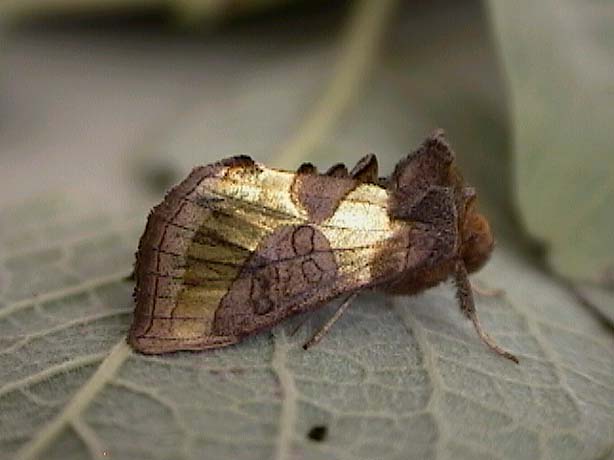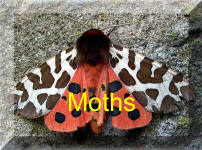ABH 73.012
Burnished Brass Diachrysia chrysitis
BF 2434
Back To
(Linnaeus, 1758)
Phenology
JAN
FEB
MAR
APR
MAY
JUN
JUL
AUG
SEP
OCT
NOV
DEC
Family
Noctuidae »
Plusiinae
Wingspan
28
- 35 mm.
Description
Common over most
of the British Isles, this spectacular moth has large areas of metallic
colouring on the forewings.
Similars Superficially resembles the rare
immigrant Slender Burnished Brass Thysanoplusia orichalcea and nationally
scarce Scarce Burnished Brass Diachrysia chryson,he length of the
forewings is 16–18 mm.
Forewing brassy green; the basal patch and
broad median fascia, widening at costa, purplish brown; subterminal
line preceded by a shade showing deeper green in certain lights;
the terminal area paler brown; the three stigmata with dark outlines;
hindwing fuscous with the fringe pale; in the ab. juncta Tutt the
median fascia is more or less widely broken in the middle, the two
brassy green areas becoming confluent; - in ab. aurea Huene the
green is deep golden, with the golden bands confluent; ab. disjuncta
Schultz, golden with the bands not confluent, while in ab. scintillans
Schultz the bands are dull blue green
Forms include f. juncta disjuncta & aurea
Life Cycle
The species is double-brooded, with moths
on the wing between June and September.
Habitat
The
Larva feeds on Stinging Nettle,(Urtica dioica) White Dead-nettle,
Wild Marjoram, Lesser Burdock and Spear Thistle. and the species inhabits
gardens, waste ground and marshy areas.t
Links
Images

ABH 73.012 |
Burnished Brass Diachrysia chrysitis |
BF 2434 |
|||||||||||||
|
|
|||||||||||||||
| Back To | (Linnaeus, 1758) |
||||||||||||||
|
|||||||||||||||
Phenology |
|
||||||||||||||
Family |
Noctuidae » Plusiinae | ||||||||||||||
Wingspan |
28 - 35 mm. | ||||||||||||||
Description |
Common over most
of the British Isles, this spectacular moth has large areas of metallic
colouring on the forewings. Similars Superficially resembles the rare
immigrant Slender Burnished Brass Thysanoplusia orichalcea and nationally
scarce Scarce Burnished Brass Diachrysia chryson,he length of the
forewings is 16–18 mm. Forewing brassy green; the basal patch and broad median fascia, widening at costa, purplish brown; subterminal line preceded by a shade showing deeper green in certain lights; the terminal area paler brown; the three stigmata with dark outlines; hindwing fuscous with the fringe pale; in the ab. juncta Tutt the median fascia is more or less widely broken in the middle, the two brassy green areas becoming confluent; - in ab. aurea Huene the green is deep golden, with the golden bands confluent; ab. disjuncta Schultz, golden with the bands not confluent, while in ab. scintillans Schultz the bands are dull blue green Forms include f. juncta disjuncta & aurea |
||||||||||||||
Life Cycle |
The species is double-brooded, with moths on the wing between June and September. | ||||||||||||||
Habitat |
The Larva feeds on Stinging Nettle,(Urtica dioica) White Dead-nettle, Wild Marjoram, Lesser Burdock and Spear Thistle. and the species inhabits gardens, waste ground and marshy areas.t | ||||||||||||||
Links |
|
||||||||||||||
Images |
|
||||||||||||||
|
|
|||||||||||||||

